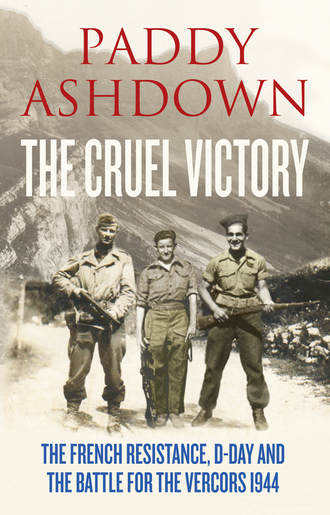
Полная версия
The Cruel Victory: The French Resistance, D-Day and the Battle for the Vercors 1944
At the end of the second week of March the redoubt strategy was raised again when local Resistance leaders met in Annecy to decide what should be done about the Maquis groups now gathered in strength on the Glières plateau. Most of the local Resistance commanders were opposed to a fixed defence of the plateau. But their opinion was overruled by a representative from London who attended the Annecy meeting. According to one of those close to these events, London’s man told the gathering that they ‘had to give London the proof that the Resistance is not just talk, but a considerable force which the Germans will have to reckon with’. In the end, despite heavy reservations, it was this opinion which prevailed.
London’s message that the Resistance had to prove itself in the Glières was by no means an idle one. Churchill himself was becoming increasingly dissatisfied with what he saw as the reluctance of the French, despite all the arms he was dropping to them, to go on to the offensive. On 14 February, Desmond Morton, Churchill’s personal assistant, wrote a note to Lord Selborne, the minister in charge of SOE: ‘In general the PM thinks that we must make the French show much greater zeal in trying to remedy their own considerable defects.’
It was not long before the Annecy decision to defend the Glières as a redoubt was tested. On 26 March Pflaum launched a mixed force of 3,000 troops supported by artillery and aircraft against the plateau. Two battalions of Gebirgsjäger scaled the ramparts of the ‘impregnable fortress’ by night with relative ease. It was all over in less than four days and was followed by the usual shootings, burning of farms and an extensive programme of reprisals.
While most of the major Resistance actions in the month of February 1944 took place in and around the Glières plateau, the Vercors was not without its excitements. On 28 February, Peter Ortiz sent an urgent signal to London reporting that the Germans were about to mount an attack on the plateau with three mechanized battalions and some light tanks. In fact, the rumour (it was unsubstantiated) seems to have reached the Vercors a few days previously, for, on 25 February, Narcisse Geyer’s regimental journal reported a ‘Major alert: imminent powerful German attack’ and described the unit’s night flight to new positions. Elsewhere that night, across the plateau, other camps were hurriedly packing up kit, squirrelling away ammunition in nearby caves and then scurrying into the forest in small groups. The false alarm had a bad effect on morale, causing ‘a profound disappointment, even real irritation in all the camps … We had somehow waited for, even looked forward to, an attempt at a “heavy blow” [from the Germans], believing totally in the natural protection the plateau afforded us as the defenders. And now, at the first sign of serious threat, we were told to disperse and hide! It made us all feel very deflated,’ said André Valot.
By this time Francis Cammaerts was already back in the area. He had parachuted into France on the night of 9/10 February after three months in which he had been rebriefed and had taken some holiday with his wife. His arrival, however, was less congenial than he might have hoped for: the parachute site chosen for that night was at Castellane, 170 kilometres south-east of the Vercors. But when the Halifax arrived in the area, after an uncomfortable journey through heavy flak, they found the site completely obscured by cloud. ‘The dispatcher told me … the mission was aborted. The next thing I knew was him saying we’d have to jump – the aircraft was on fire … As I jumped I could see that it was ablaze. As I was descending I realised the huge canopy of the parachute fell more slowly through thick cloud than it would through clear sky. So I was going down very slowly. It was like being in a dense London smog virtually the whole time – I don’t know how many minutes it took from 10,000 feet but it seemed an eternity … When I finally came out of the cloud I had 25 metres to go! A potato patch is the softest part of a farm you could wish for and there one was, and I hit it. In that filthy weather I could have landed in the middle of Lyon, not on a lonely farm.’
Cammaerts’ orders for this, his second mission, instructed him to pursue his leapfrog plan to use the Valensole, Vercors and Beaurepaire plateaux as ‘bridgeheads’ on which Allied paratroopers could land, adding that this had now been formally approved for consideration as part of Operation Anvil, the Allies’ planned southern invasion on the Mediterranean coast. The strategic importance of the Vercors plateau in the event of either an invasion from the south or an attack across the Alpine passes had been confirmed.
* On 10 June, four days after D-Day, Albert Chambonnet was arrested by the Gestapo. He was shot on 27 July at Lyon.
14
MARCH 1944
The instructions given by Winston Churchill in February 1944 that arms drops to the Resistance should be doubled in the month of March produced swift results, most, but not all of them, welcome to the Vercors. On 4 March, in what seems a desperate measure to dispatch arms by any means, the RAF carried out a ‘blind drop’* of containers near Romans. Peter Ortiz, who was in the area at the time, complained bitterly to London in an ‘outspoken denunciation … As soon as he received the warning [of the drop] he left to try to stop the Germans recovering the material which had been dropped, but it was they who had the largest share. Such operations put the whole region into an excited state and expose the population to harsh reprisals as well as putting the reception committees to unjustifiable risks.’
On 10/11 March, the night of the March full moon, the first major parachute drop the plateau had received since Darbonouse four months previously took place when five Stirling heavy bombers successfully parachuted containers at a site codenamed Gabin, 2 kilometres west of Saint-Martin-en-Vercors, in an open valley surrounded by woods.
Five days later, at 01.05 hours on 16 March 1944, a Halifax bomber captained by Pilot Officer Caldwell took off from RAF Tempsford on Operation Bob 149. His mission was to drop eighteen containers packed with arms and seven packages to the Gabin site. Caldwell crossed the Channel and, skirting Paris, continued south over Burgundy and Bourg-en-Bresse to his final landmark, the Lac de Charavines, 60 kilometres north-west of his target. The lake was not difficult to spot, its silver surface shimmering like a mirror in the moonlight. Here Caldwell started his twenty-minute ‘dead reckoning’ run in to his target. His after-action report is brief: ‘Pinpointed lake WNW of Target & ground detail. Lights on when aircraft arrived’.
Judging from Caldwell’s description, he overflew the target from the north in order to establish its precise location and exchange code signals with the reception team: ‘Good reception and correct letter’. Banking his aircraft, he retraced his steps from the south, the moon now shining over his right shoulder. With the Gabin site visible, he reduced his height above the ground to a spine-tingling 120 metres. On his first run, he dropped nine containers and five packages before pulling out to avoid the high ground north of the Gorges de la Bourne, swinging the big Halifax round again and repeating the same procedure from the north to south, dispatching the remaining nine containers and two packages. Caldwell had arrived over Gabin at 04.02 hours and, twenty minutes later, his mission accomplished, he was heading home for Tempsford. He had an uneventful return journey, dropping leaflets over the little Burgundy town of Époisses, half hidden in the ‘ground haze over northern France’, and touching down at his home base a little before dawn at 07.10.
Конец ознакомительного фрагмента.
Текст предоставлен ООО «ЛитРес».
Прочитайте эту книгу целиком, купив полную легальную версию на ЛитРес.
Безопасно оплатить книгу можно банковской картой Visa, MasterCard, Maestro, со счета мобильного телефона, с платежного терминала, в салоне МТС или Связной, через PayPal, WebMoney, Яндекс.Деньги, QIWI Кошелек, бонусными картами или другим удобным Вам способом.




